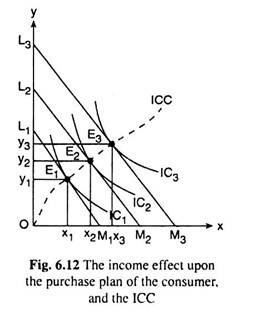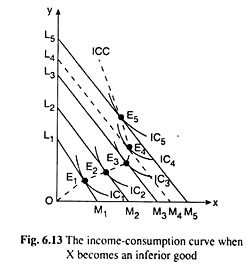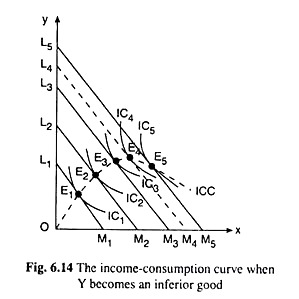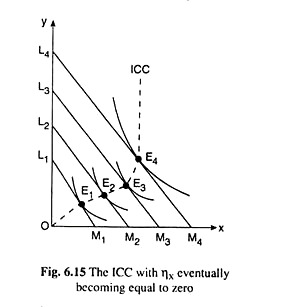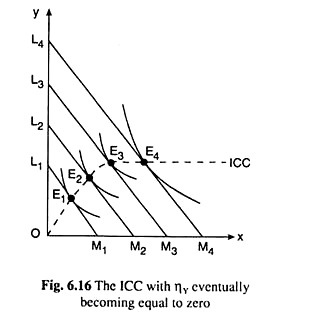In this article we will discuss about the shape of the Income-Consumption Curve (ICC), explained with the help of a diagram.
The shape of an ICC depends on whether both the goods are normal, i.e., non-inferior, or whether one of them is normal, and the other one is inferior.
If both the goods are normal (barring ηx, ηY = 0), then as the money income of the consumer rises, prices remaining constant, he would be buying both the goods in larger quantities and moving to newer equilibrium points upward towards right along his ICC. In other words, ICC, in this case, would be sloping upward towards right, like the ICC given in Fig. 6.12.
On the other hand, it may so happen that initially both the goods are normal, and as the consumer’s income rises and his budget line gets parallel rightward shifts, the purchase of both the goods may increase and ICC may be sloping upward towards right.
ADVERTISEMENTS:
But as his income reaches a certain high level, the consumer may think that he is sufficiently rich not to increase the purchase of one of the goods, say X, rather decrease its purchase, as his income rises beyond that level.
That is, as the consumer’s income has reached the said ‘high’ level, good X has suddenly become an inferior good to the consumer.
Since the consumer purchases X in smaller quantities as his income rises beyond the ‘high’ level and he purchases the normal (or superior) good Y in larger quantities, the ICC would be sloping upwards towards left, i.e., it would bend towards the Y-axis, as his income rises. This type of ICC has been shown in Fig. 6.13.
Similarly, if the consumer regards Y as an inferior good as his income rises beyond a certain ‘high’ level, his ICC which had been sloping upward towards right so long, would be sloping downwards towards right, i.e., his ICC would bend towards the x-axis as his income rises beyond the ‘high’ level.
He would now buy the normal (or superior) good, X, in larger quantities and the inferior good Y in smaller quantities as his income rises beyond the ‘high’ level. This type of ICC has been shown in Fig. 6.14.
Lastly, if η > 0 initially for both the goods and then as income rises beyond a certain ‘high’ level, if η becomes equal to zero (η = 0) for, say, good X, being greater than zero for the other good (Y), then the ICC would be initially upward sloping and then at the said ‘high’ level of income it would become a vertical straight line, i.e., parallel to the Y-axis (Fig. 6.15).
Similarly, if eventually r) becomes equal to zero for good Y, being greater than zero for good X, then also the ICC after sloping initially upward towards right would eventually become a horizontal straight line or parallel to the X-axis (Fig. 6.16).
It may be noted here that the reason why both the goods cannot be inferior at the same time applies equally to why for both the goods η cannot be equal to zero at the same time. If η is equal to zero for one of the goods, then it must be greater than zero for the other good.
